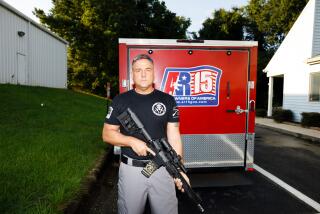Exhibit Aims at the Memory of Revolver’s Inventor
HARTFORD, Conn. — In the world of gun collecting, Sam Colt’s name is revered. In his hometown, it often draws a blank.
The inventor of the first gun with a revolving cylinder has been all but forgotten by the city where he lived and built a gun-manufacturing empire.
No visitors flock to the former Colt Armory or to his Italian-style villa the way tourists pay homage to the home of Mark Twain. No tours take visitors to his grave.
A Hartford museum’s exhibit about Colt, his family and his famous Colt .45 aims to change that.
“Sam and Elizabeth: Legend and Legacy of the Colt Empire,” opened this month at the Wadsworth Atheneum. The six-month exhibit includes about 350 items, including photographs, drawings and music from 19th-century Hartford and 70 guns.
“All gun collectors kind of genuflect at the shrine of Colt,” said co-curator William Hosley.
The exhibit includes the wooden gun that Colt carved when he first invented the revolving firearm, and a gilded zinc statue of a colt with a broken spear in its mouth that once stood atop the armory’s blue, onion-shaped dome. Known as the Rampant Colt, the statue was a symbol of Hartford’s industrial might.
Colt came up with the idea for the revolving firearm on a boat trip from Boston to Calcutta in 1830--when he was just 16--by staring at the ship’s rotating wheel.
He got his break in 1845, when Sam Walker of the Texas Rangers came looking for Colt weapons to handle skirmishes in Texas, which had just broken away from Mexico.
Without a factory, Colt appealed to Eli Whitney, son of the inventor of the cotton gin, to produce the guns in Whitneyville, just north of New Haven.
Colt later expanded to a Hartford factory that produced about 1,000 firearms a year, before moving to the riverside armory.
Known as “Coltsville,” it was the world’s largest private gun factory. From Colt’s estate one could see the H-shaped facility, employing about 1,400 people to produce about 150 guns a day. Housing for workers, including many German and Irish immigrants, was nearby.
Even Twain was impressed: A visit to the armory in the late 1800s inspired him to write “A Connecticut Yankee in King Arthur’s Court.”
The company still exists in some form. The armory burned down in 1864 but was rebuilt. Colt’s Manufacturing Co. emerged from bankruptcy in 1994 and now operates from a plant in suburban West Hartford. It is not a sponsor of the exhibit.
Colt’s legacy extends beyond guns. Workers at his armory included several future leaders in the defense industry, including Francis A. Pratt and Amos Whitney of Pratt & Whitney Aircraft.
“The defense industry started with Colt. He planted that seed,” co-curator Karen Blanchfield said.
And many of the buildings that Colt left behind have found new uses.
Armsmear, the Colt family villa, serves as a home for widows. The rest of the estate was turned into city-run Colt Park, which includes a statue of the young Sam Colt. Sections of the old armory serve as offices and studios.
A church decorated with gun carvings that Elizabeth Colt had built in her husband’s memory has a congregation. Even a section of the Wadsworth was built with Colt money.
“They built so much for Hartford. They were single-handedly responsible for Hartford, Conn., being known around the world,” Blanchfield said.
More to Read
Sign up for The Wild
We’ll help you find the best places to hike, bike and run, as well as the perfect silent spots for meditation and yoga.
You may occasionally receive promotional content from the Los Angeles Times.





